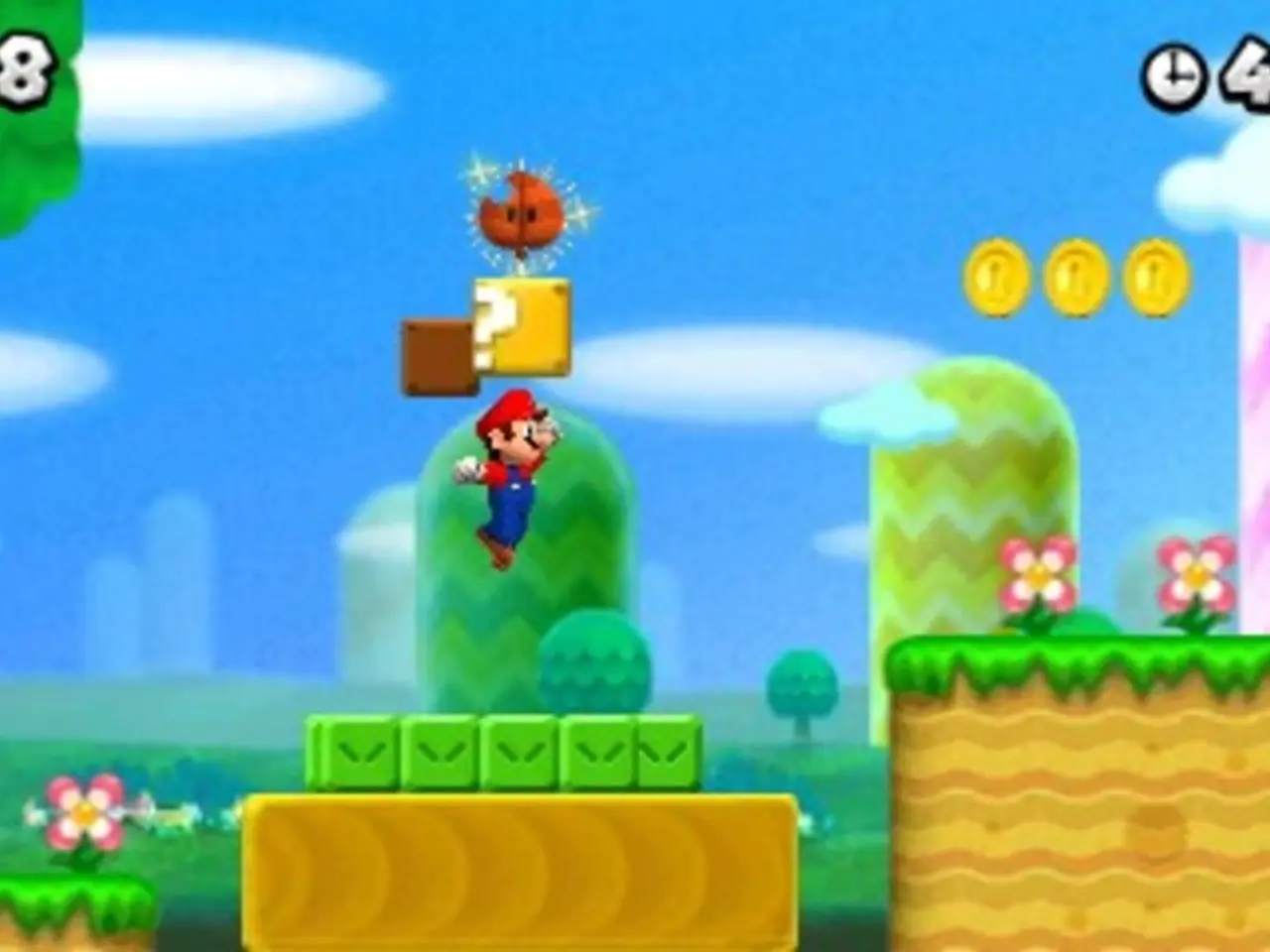Victory over inflation's impact
Credit card innovation aimed at tackling inflation: an overview
In these times of sky-high prices, a smart move for battling inflation's repercussions could be opening a credit card that lets you reap cash-back rewards, credit card bonuses, and other perks to offset the extra costs you're facing. But remember, always use these cards wisely and avoid carrying a balance to keep the interest costs at bay.
With inflation hitting the gas pump, grocery stores, and various other places you wouldn't dare embrace, it's not the greatest news, but Americans have weathered these storms before. From cutting costs at the store to scouting out deals, we've always found ways to minimize the negative effects of high prices, even as they start to retreat.
By strategically utilizing your credit cards, you might be able to secure discounts in common spending categories where the prices are creeping up. Adding a credit card that fits your lifestyle, especially one with hefty rewards and a competitive interest rate, could be another handy tool in your fight against the steep costs.
Here are some tips on how to use your credit card, new or old, to challenge inflation, regardless of its level:
The influence of high inflation on credit card debt
After a prolonged streak, the Consumer Price Index (CPI)—one of the most widely used inflation measures, accounting for consumer costs ranging from grocery items to gasoline—soared up to 9.1% in June 2022, as reported by the U.S. Bureau of Labor Statistics. Although this rate has since dropped to 2.4% as of March 2025, it's still somewhat higher than the 2% inflation rate that the Federal Reserve typically aims for.
Translation: during the past few years, the spending power of the American dollar has been significantly weakened, meaning it takes a bigger chunk of our hard-earned cash to buy products and services.
In an attempt to curb inflation, the Federal Reserve held the target federal funds rate within a range of 5.25% to 5.50%—up from 0.75% to 1.00% at the beginning of June 2022—for quite a spell. When the Fed boosts up that rate, the impact typically trickles down to the interest rates for credit cards. How? When the federal funds rate goes up, the prime rate usually follows suit, leading to increased interest rates for credit cards as well.
In September 2024, the Fed eventually started to cutting interest rates, beginning with a half percentage point, for a new target range of 4.75% to 5%. In December 2024, they followed up with a further quarter-point cut, setting their sights on a range of 4.25% to 4.50%. They kept interest rates steady in their May 2025 meeting. Even as the rates have come down, credit card debt remains expensive debt.
As of April 2025, the average credit card interest rate stands at 20.09%, according to our website data. This increase—up from an average of 16.17% in 2022—means that carrying a balance on your credit card is getting pricier for many consumers.
Unfortunately, even though there has been progress in the Federal Reserve's efforts to control inflation—the Fed's interest rate cuts are evidence of that—Americans may not witness immediate relief. That's because the higher prices resulting from past inflation continue to decrease individuals' ability to save up. A credit card can help bridge the gap and return some funds to your pocket.
How the right card can reduce the blow of high pricing
Much like inflation whittles away the worth of cash, it can also eat away at the value of credit card transactions. However, a credit card featuring robust rewards, bonuses, and benefits can help you offset inflation and inflated prices. Here's how:
It can offer enticing rewards
Credit card rewards can save you cash on your everyday purchases, especially if the rewards manifest in the form of cash-back. Depending on the category and your credit card, you could receive anywhere from 1% to 5% back or even more. If you have a travel credit card that dishes out points or miles, you might stretch your savings even further by using the rewards to offset some of your travel expenses.
On top of that, the sign-up bonus you receive when you open a new rewards card can help ease the financial strain of rising prices, particularly if you plan to make a major purchase.
Keep in mind: These rewards will only offset inflation costs if you manage to pay off your credit card balance each month. If you carry a balance, you'll be charged interest, which will most likely neutralize the benefits of any rewards you've earned.
It can help you save on essentials like gas and groceries
Prices for food have risen an average of 3.0% from March 2024 to March 2025, as indicated by data from the U.S. Bureau of Labor and Statistics, while electricity and home gas service rates seem to have gone up by 4.2% for the same period. This gradual decrease in inflation is encouraging, but consumers are still feeling the pinch of steep costs on essentials.
According to March 2025 data from the U.S. Department of Agriculture, the typical family of four with two adults and two kids ages eight and 10 is now spending $1,327 per month on a moderate food spending plan—a significant chunk of change.
The silver lining here is that credit cards can offer a helping hand. Plenty of cards provide rewards on groceries and food delivery, dining out, gas at the pump, and other common spending categories.
In some instances, you can discover a credit card that covers multiple categories—for example, a flat-rate cash-back card that rewards you with the same cash-back rate on all spending. With this strategy, no matter which credit card you opt for, you'll be earning rewards on the food, fuel spending that you would have done anyway.
What to ponder when selecting a credit card
If you're on the lookout for credit cards that deliver generous high-price-fighting rewards, make sure to consider these factors before settling on a choice:
- Your overall spending patterns: Look over your expenditures from the past few months to locate a card that rewards your day-to-day expenses.
- The kind of rewards you aspire to earn: You might benefit from a credit card that dishes out an attractive amount of cash-back on grocery purchases. Or perhaps you jet-set quite a bit now and would find a travel credit card that leverages points or miles to be more advantageous.
- How straightforward it is to snag the card's welcome bonus: A welcome bonus can help mitigate expenses, but only if you don't end up avec a major credit card debt to obtain it. Find a card with a welcome bonus that suits your budget.
- The interest rate you're comfortable with: Many rewards credit cards extend a 0% introductory APR for at least 12 months to increase their worth, although the best 0% APR cards can go up to 21 months—but it's the regular, fluctuating APR that you really need to give a glance. There may come a moment in time when you have to cope with a balance on your card, so opting for one with an APR lower than average could save you a pretty penny when it comes to longer-term loans.
Our website's top picks for tackling inflation with credit card rewards
Blue Cash Preferred® Card from American Express
- If you're keen on earning cash-back on your grocery and gas spending, the Blue Cash Preferred® Card from American Express is a fantastic option for both categories. This card comes with a $0 annual fee during the inaugural year of ownership, followed by a $95 fee after that. You'll receive:
- 6% Cash Back at U.S. supermarkets on up to $6,000 annually in purchases (then 1%).
- 6% Cash Back on select U.S. streaming subscriptions.
- 3% Cash Back at U.S. gas stations and on transit (including taxis/rideshare, parking, tolls, trains, buses, and more).
- 1% Cash Back on other purchases.
- The Amex Blue Cash Preferred is a solid option if your grocery budget is average, as there's an $6,000 yearly cap on grocery spending (maximum of $360 in cash-back earnings within that category). Besides helping you save on fuel, if you utilize public transportation, you'll earn 3% back in that category as well. Plus, you can score a $250 welcome bonus upon spending $3,000 within the first six months from account opening.
Chase Sapphire Preferred® Card
- The Chase Sapphire Preferred® Card entails an annual fee of $95, but you can recoup that pretty quickly depending on how you wield it. With the Chase Sapphire Preferred, you'll gain:
- 5x on travel purchased through Chase TravelSM.
- 3x on dining, select streaming services, and online groceries.
- 2x on all other travel purchases.
- 1x on all other purchases.
- This Chase card includes enticing benefits and credits, like a 10% anniversary point bonus and the ability to redeem your points for 25% more value when booking travel through the Ultimate Rewards portal. However, the fact that you can score more rewards on groceries, dining, and dining at home with this card deserves emphasis. Additionally, any delivery order you place will still earn 3X points. Since this card lets you cash in your rewards for statement credits at a rate of one cent per point, you could potentially redeem points to offset your credit card bill after shopping if you decide against saving up for travel.
Bank of America® Customized Cash Rewards credit card
- The Bank of America® Customized Cash Rewards credit card does not entail an annual fee, and rewards:
- Earn 3% cash back on your chosen category (up to $2,500 in combined choice category/grocery store/wholesale club quarterly purchases).
- Earn automatic 2% at grocery stores and wholesale clubs (up to $2,500 in combined choice category/grocery store/wholesale club quarterly purchases).
- Earn unlimited 1% on all other purchases.
- This card suits those seeking flexibility in their spending categories, as it comes with 3 percent back in one category of your choosing that you can change monthly. With this strategy, you can combine your grocery earnings with rewards on purchases in accordance with your anticipated spending for the month. Some categories worth considering include:
- General travel
- Home improvement
- Gas & EV charging stations
- Online shopping (including Cable, Streaming, Internet, and Phone services)
- Drugstores
- DiningNew cardmembers can also earn a $200 online cash rewards bonus after spending $1,000 on purchases in the first 90 days from account opening. If you're a Bank of America Preferred Rewards member, you could boost your cash back by up to 75%.
Citi Custom Cash® Card
- The Citi Custom Cash® Card does not offer a bonus category for groceries or gas, per se, but it does grant 5% cash-back on your top eligible spending category (up to $500 per billing cycle, then 1%), out of 10 top spending category options. Gas stations, select travel costs, and select transit expenses are among these top 10 categories—and even if you hit the $500 limit, you'll still earn 1% back.
Through June 30, 2026, you can also garner 4% cash-back on hotels, car rentals, attractions booked on the Citi TravelSM portal.* Given that many consumers' top spending categories often fall under food or fuel, hitting the $500 monthly threshold is relatively attainable, and the card offers 5% cash-back (which you'll receive in the form of Citi ThankYou Points, despite this card being marketed as a cash-back card). These points can be swapped for cash with a direct deposit, check, or statement credit. You can also exchange your points for gift cards, travel through Citi, or eligible purchases on Amazon with Shop with Points.
The Citi Custom Cash also extends the option to earn 20,000 ThankYou Points worth $200 by spending $1,500 within the first six months from account opening.
Costco Anywhere Visa® Card by Citi
- The Costco Anywhere Visa® Card by Citi has no annual fee, but a $65 Costco membership is required to possess the card. The card deals:
- 5% cash-back on gasoline, plus 4% cash-back on eligible gas and EV charging purchases (caplimited to $7,000 annually, then 1%).
- 3% cash-back at restaurants, as well as eligible travel expenses.
- 2% cash-back on all Costco and Costco.com purchases.
- 1% cash-back on everything else.
- This card is ideal for die-hard Costco customers exclusively, as you'll receive your rewards as a single credit card reward certificate that can only be used in-store. This certificate can be redeemed once a year subsequent to your February billing statement. If you're a regular Costco patron, this card could still prove to be worth it.
If you have a penchant for wholesale clubs but fancy Sam's Club more, for example, the Sam's Club® Mastercard® might be worth considering as it offers a nearly identical rewards structure and redemption options.
Other money-saving strategies
Here are some additional suggestions that could help you extend your savings further:
- Check out rotating bonus category cards: If you aren't bent on any of the cards mentioned above, you might be interested in a credit card offering rotating bonus categories, like the Discover it® Cash Back, which offers 5% cash-back on activated rotating bonus categories each quarter (on up to $1,500 in spending per quarter, then 1%). With a 5% cash-back rate, this card can offer a decent fight against inflation on category purchases.
- Double-dip with cash-back apps: Browse through a range of cash-back apps to boost your grocery and gas discounts. Examples of cash-back apps include Ibotta or Fetch Rewards for groceries, and Upside or loyalty programs for saving at the pump while also obtaining credit card rewards on your fuel spending.
- Formulate a solid budget: Formulating a spending plan doesn't always necessitate cutting back. You may be able to rejig your expenses or discover additional methods to earn money that help mitigate the financial shortfall. The goal is to assess your spending patterns and uncover ways to modify your budget in a way that allows you to endure increasing prices.
- Avoid credit card interest like the plague: While rewards won't benefit you if you're shouldering a credit card balance from month to month, transferring your high-interest debt to a credit card featuring a 0% interest rate for an extended period might help reduce interest costs during inflationary periods.
The lowdown
Past inflation has been the catalyst behind higher pricing for everyday items from milk to luxury vehicles. Given that Americans continue to grapple with the repercussions of inflation (even as the inflation rate itself drops), some are discovering that a new credit card—particularly one that offers enticing rewards and a sign-up bonus—can help.
But before you dive into shopping for the best rewards credit card to beef up your anti-inflation arsenal, consider whether cash-back, points, or miles are best suited for your lifestyle. Additionally, strive to settle your credit card balance in full each month to ensure that the value of your rewards prevails over any credit card interest as you wage war against steep prices.
**Information about the Citi Custom Cash® Card, Costco Anywhere Visa® Card by Citi,** and Sam's Club® Mastercard® has been collected independently by our website. The card details have not been approved or reviewed by the issuer. The Bank of America content in this post was last updated on May 7, 2025.**
- Despite the drop in inflation rate, credit card debt remains expensive, with the average credit card interest rate standing at 20.09% as of April 2025, according to the website data.
- A smart strategy to offset the costs of inflation could be adding a credit card that fits your lifestyle, especially one with hefty rewards and a competitive interest rate, in common spending categories where prices are creeping up.
- In March 2025, the typical family of four with two adults and two kids ages eight and 10 was spending $1,327 per month on a moderate food spending plan. Credit cards can offer rewards on groceries and food delivery, dining out, gas at the pump, and other common spending categories, helping consumers save on essentials like groceries.




